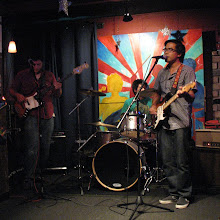This particular Jazzmaster is a made in Japan model ("Crafted in Japan" for all those Fender afficionados), and appears to be emulating an early 60's style JM with the tortoise shell pickguard, a 7.25" radius fretboard, thicker neck profile, and all the normal JM fittings: two wide single coil pickups, switchable rhythm/lead circuits with volume and tone controls for each, three-way pickup selector switch, and floating vibrato.
The guitar however had several modifications. The bridge was replaced by a Mustang bridge (a common mod to Jaguars and Jazzmasters) to keep the strings from skipping out of the saddles. A tension bar, called a "Buzz Stop" was also added to increase downward force onto the bridge. This addition in my opinion affects the guitar tone significantly, making the signature plunky attack of the Jazzmaster more subtle, and significantly increasing sustain. I personally like the addition because it makes the guitar a little more versatile and adds a more fluid, singing quality to leads. The attack is still there though, so don't worry, it sounds nothing like a Stratocaster (also because of the huge pickups).
The Rhythm/Lead Circuits
One of the neatest features of this guitar is the dual circuit design. This concept is similar, though not the same as guitars like the Gibson Les Paul or SG that have volume and tone controls per pickup. On the Jazzmaster, the two circuits are actually voiced differently as they run through different value components.
The rhythm circuit is activated with the switch "up," and only uses the neck pickup; the pickup selector is made inoperable when in the rhythm circuit. The sounds is darker and mellower than the lead circuit, even with the volume and tone wide open. The idea behind this was to create a smoother, subdued jazz tone, which this guitar excels at. On clean, the guitar easily gets that cool, small club jazz sound. When overdriven, this setting is very fluid, sustaining, warm and fuzzy; fuzzy like a wool blanket I'd like to say.
The lead circuit activates the 3 position pickup selector: neck, middle (pickup blend) and bridge pickups. This circuit is significantly brighter, though can be made dark like the rhythm circuit by rolling down the tone control. Most players use the lead circuit for this reason, though I personally have found it great to be able to switch from a warm jazz tone on the rhythm circuit, to a glassy surf tone on the lead; or a jangly tone for playing chords on the lead, to a fuzzed out mess for solos on the rhythm. The possibilities are endless!!!
Floating Vibrato
Another cool feature of the Jazzmaster (also found on the Jaguar) is the "floating" vibrato. It is floating because internal springs counter the pull of the guitar strings, making it possible to up and down bend using the whammy bar. The action of the whammy is very smooth, making those surfy warbling sounds easy. The range of motion is much smaller than that of the Synchronized Tremelo bridge of the Stratocaster; this thing is not made for wild dive bombing! But for accenting, this bridge has no parallel.
Conclusion
Well I'm sure you all know what I think about this guitar. I LOVE IT! The Jazzmaster is a versatile guitar that has lots of tonal options at your fingertips. It may not be the most straightforward guitars out there, but it agrees with the way that I play and my style. It is also worth mentioning that it's one of the most ergonomic and balanced guitars I've ever played, very comfortable both sitting and standing. Now I know why the Jazzmaster has such a respected following. I'm very proud to own this guitar!
Photo Gallery
 |
| The new addition to the family: CIJ Fender Jazzmaster. Note the addition of the Buzz-Stop. |
 |
| Jazzmaster in case. |
 |
| Headstock detail, with 1960's logo styling and decals. |
Famous Jazzmaster players
Bilinda Butcher, Kevin Shields (My Bloody Valentine)
Nels Cline
Elvis Costello
John Davis (Superdrag)
Mike Einziger (Incubus)
Mike Einziger (Incubus)
Kim Gordon, Thurston Moore, Lee Ronaldo (Sonic Youth)
Ira Kaplan (Yo La Tengo)
Stephen Malkmus (Pavement)
Stephen Malkmus (Pavement)
Jeff Tweedy (Wilco)
Tom Verlaine (Television)


No comments:
Post a Comment